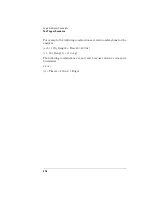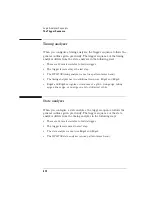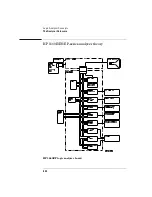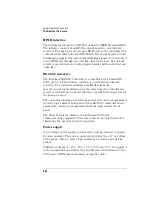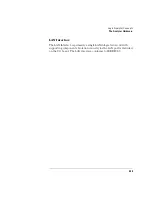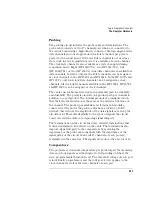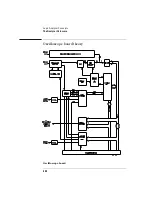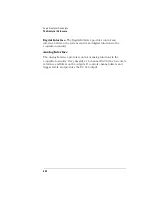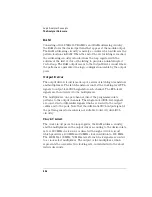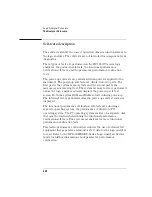
427
Logic Analyzer Concepts
The Analyzer Hardware
Probing
The probing circuit includes the probe cable and terminations. The
probe cable consists of two 17-channel pods which are connected to
the circuit board using a high-density connector. Sixteen single-ended
data channels and one single-ended clock/data channel per pod are
passed to the circuit board. If the clock/data channel is not used as a
state clock in state acquisition mode, it is available as a data channel.
The clock/data channel is also available as a data channel in timing
acquisition mode. Eight (HP 1660/70’s), six (HP 1661/71’s), four
(HP 1662/72’s), or two (HP 1663’s) clock/data channels are available as
data channels; however, only six clock/data channels can be assigned
as clock channels in the HP 1660’s and HP 1661’s. In the HP 1670’s and
HP 1671’s, only four clock/data channels can be assigned as clock
channels. All clock data channels available in the HP 1662’s, HP 1672’s,
and HP 1663’s can be assigned as clock channels.
The cables use nichrome wire woven in polyarmid yarn for reliability
and durability. The pods also include one ground path per channel in
addition to a pod ground. The channel grounds are configured such
that their electrical distance is the same as the electrical distance of
the channel. The probe tip assemblies and termination modules
connected at the end of the probe cables have a divide-by-10 RC
network that reduces the amplitude of the data signals as seen by the
circuit board. This adds flexibility to the types of signals the circuit
board can read in addition to improving signal integrity.
The terminations on the circuit board are resistive terminations that
reduce transmission line effects on the cable. The terminations also
improve signal integrity to the comparators by matching the
impedance of the probe cable channels with the impedance of the
signal paths of the circuit board. All 17 channels of each pod are
terminated in the same way. The signals are reduced by a factor of 10.
Comparators
Two proprietary 9-channel comparators per pod interpret the incoming
data and clock signals as either high or low depending on where the
user- programmable threshold is set. The threshold voltage of each pod
is individually programmed, and the voltage selected applies to the
clock channel as well as the data channels of each pod.
Summary of Contents for 1670E Series
Page 6: ...6 In This Book...
Page 26: ...26 Contents...
Page 27: ...27 Section 1 Logic Analyzer...
Page 28: ...28...
Page 29: ...29 1 Logic Analyzer Overview...
Page 39: ...39 2 Connecting Peripherals...
Page 49: ...49 3 Using the Logic Analyzer...
Page 72: ...72 Using the Logic Analyzer The Inverse Assembler...
Page 73: ...73 4 Using the Trigger Menu...
Page 101: ...101 5 Using the Oscilloscope...
Page 151: ...151 6 Using the Pattern Generator...
Page 199: ...199 7 Triggering Examples...
Page 237: ...237 8 File Management...
Page 249: ...249 9 Logic Analyzer Reference...
Page 360: ...360 Logic Analyzer Reference The Compare Menu...
Page 361: ...361 10 System Performance Analysis SPA Software...
Page 397: ...397 11 Logic Analyzer Concepts...
Page 430: ...430 Logic Analyzer Concepts The Analyzer Hardware Oscilloscope board theory Oscilloscope board...
Page 439: ...439 12 Troubleshooting the Logic Analyzer...
Page 455: ...455 13 Specifications...
Page 471: ...471 14 Operator s Service...
Page 479: ...479 Operator s Service Troubleshooting Troubleshooting Flowchart 2...
Page 491: ...491 Section 2 LAN...
Page 492: ...492...
Page 493: ...493 15 Introducing the LAN Interface...
Page 497: ...497 16 Connecting and Configuring the LAN...
Page 506: ...506 Connecting and Configuring the LAN Connecting and Configuring the LAN...
Page 507: ...507 17 Accessing the Logic Analyzer File System Using the LAN...
Page 515: ...515 18 Using the LAN s X Window Interface...
Page 527: ...527 19 Retrieving and Restoring Data Using the LAN...
Page 539: ...539 20 Programming the Logic Analyzer Using the LAN...
Page 546: ...546 Programming the Logic Analyzer Using the LAN Programming the Logic Analyzer Using the LAN...
Page 547: ...547 21 LAN Concepts...
Page 555: ...555 22 Troubleshooting the LAN Connection...
Page 580: ...580 Troubleshooting the LAN Connection Getting Service Support...
Page 581: ...581 Section 3 Symbol Utility...
Page 582: ...582...
Page 583: ...583 23 Symbol Utility Introduction...
Page 588: ...588 Symbol Utility Introduction Symbol Utility Introduction...
Page 589: ...589 24 Getting Started with the Symbol Utility...
Page 597: ...597 25 Using the Symbol Utility...
Page 609: ...609 26 Symbol Utility Features and Functions...




